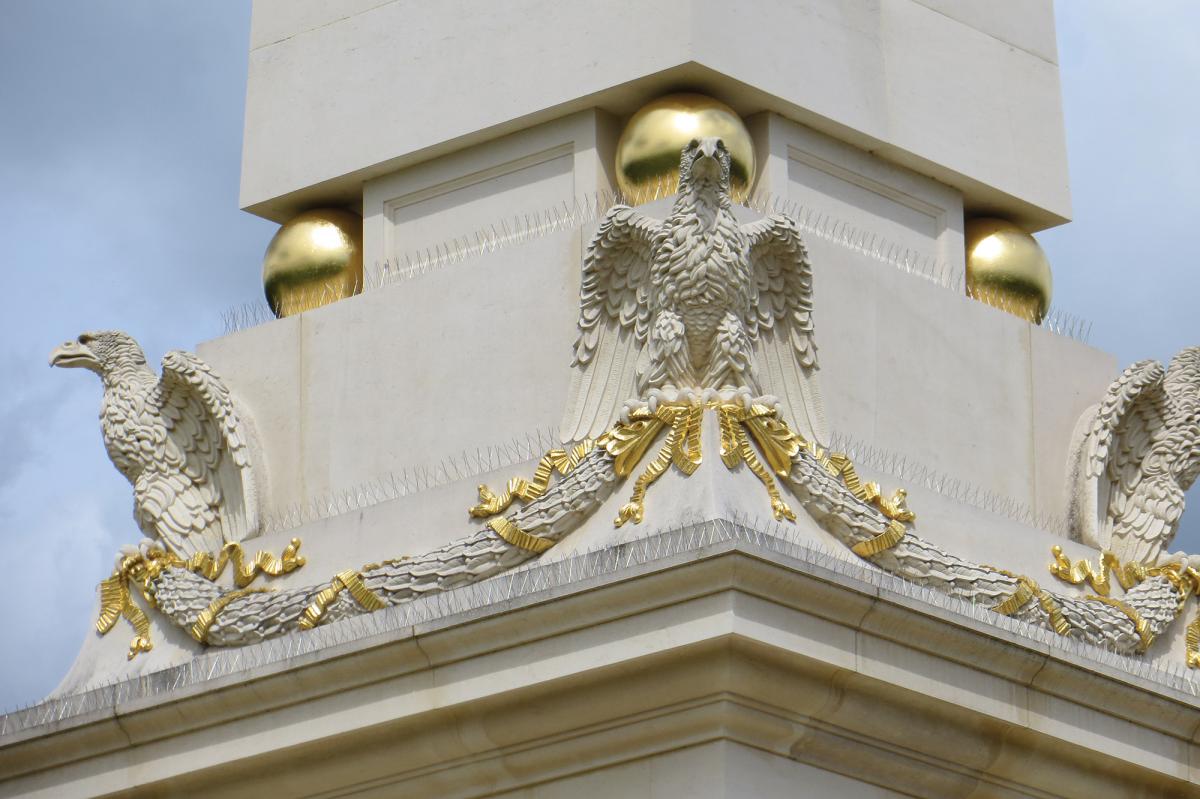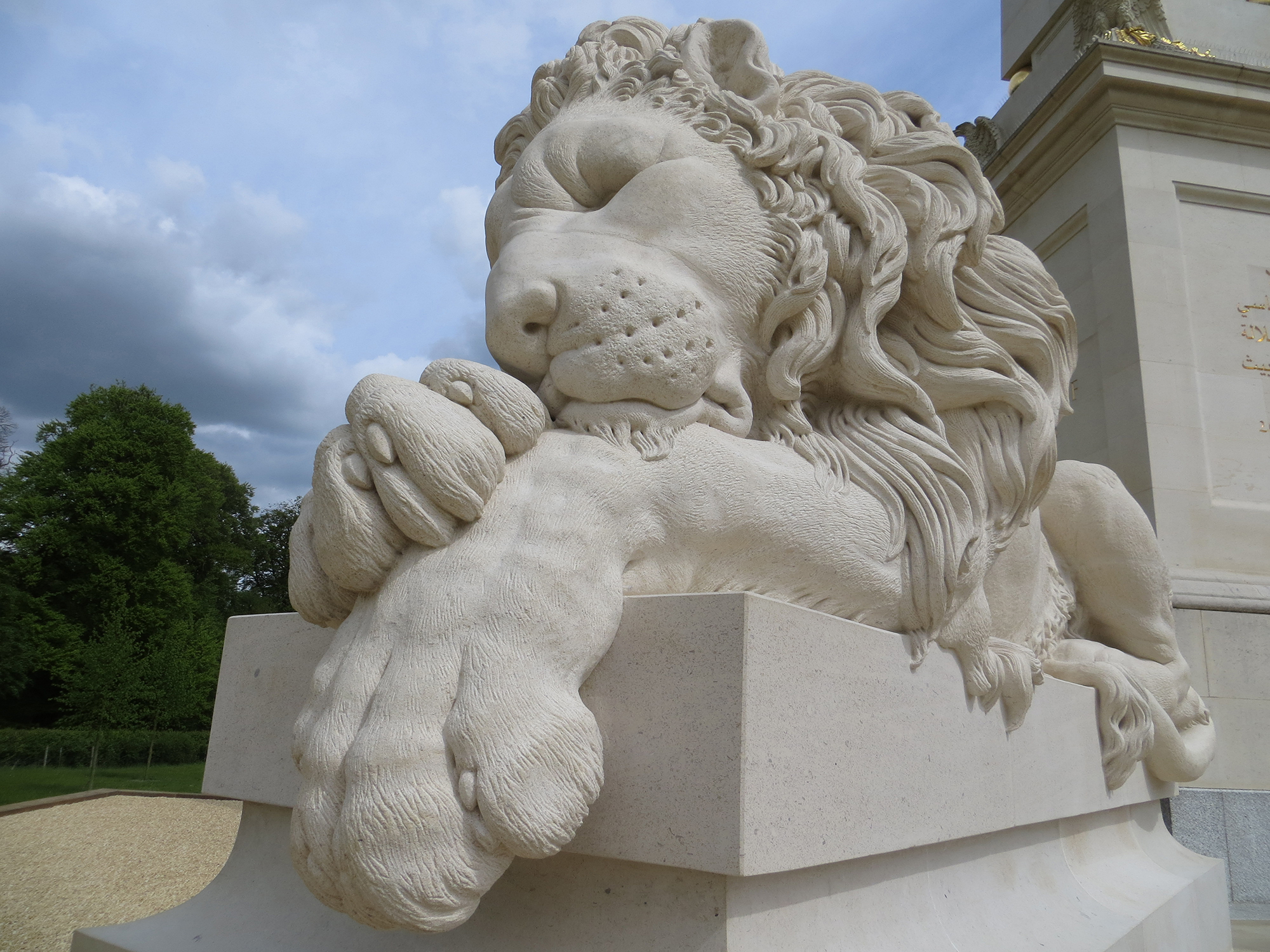Readers projects : Canova's lions
A 27m obelisk erected to mark the diamond jubilee of The Queen in 2012 is now guarded by four, huge Massangis limestone lions, two constantly vigilant while the other two sleep. The sculptures are the result of the fusion of the finest craft skills and the most advanced technology the industry can offer. NSS visited the finished monument.
There was a picture of one of these limestone lions being hand-finished in the workshops of Chichester Stoneworks in the March issue of Natural Stone Specialist. The pictures here show what the four lions produced look like now they are finished and installed – although it was a condition of being able to see them that we do not mention precisely where they are.
The lions are based on copies in the sculpture gallery at Chatsworth House of lions carved by Canova for the tomb of Pope Clement XIII in St Peter’s Church in Vatican City, Rome. The latest versions are 60% larger than the originals with each one created from five carefully selected blocks of the finest Massangis stone.
 Adam Stone, Managing Director of Chichester Stoneworks and a convert to the power of technology, saw at concept stage with the Architect, Andrew Lockwood, that the only way to make the project viable was to embrace the most advanced techniques available. This would involve scanning to capture and create digital images to be used in computer-aided design and manufacture, married to the best traditional hand skills of Chichester Stoneworks.
Adam Stone, Managing Director of Chichester Stoneworks and a convert to the power of technology, saw at concept stage with the Architect, Andrew Lockwood, that the only way to make the project viable was to embrace the most advanced techniques available. This would involve scanning to capture and create digital images to be used in computer-aided design and manufacture, married to the best traditional hand skills of Chichester Stoneworks.
Chichester Stoneworks was the principal contractor for the project. The company brought together a team that fitted the bill.
Laser scans were taken of the lions in the sculpture gallery Chatsworth House, thanks to the kind permission and collaboration of Chatsworth House.
Because they were originally part of a tomb, they had unworked, missing sections where the sculptures were against a wall. These missing sections were modelled on the computer to create full lions in the round. As Adam says: “What people don’t appreciate is that 40% of the lions we see today didn’t exist at all on the originals. This was all sculpted in cyberspace by an incredibly talented individual.”
Once the images had been developed and approved – a necessarily detailed and involved process taking many hours and several live and Skype development meetings with the architect and Chichester Stoneworks – they could be converted into files that the machinery at Stoneworld in Oxfordshire could understand.
It was important to understand the capabilities of the robot and what the team wanted from it. “There comes a point,” says Adam, “where to use the resources as efficiently as possible you have to decide that the machine has done all it needs to do and where the hand must take over. We set those parameters at 3mm above the finished surface for all but the face. We had decided very early on in the process that for the project to be a success it was imperative we create as faithful a recreation of Canova’s lions as was possible. The mask in our view was central to this and therefore the point where the hand took over was on the line.”
For the robot, projects like this are not about the hardware, says Rob Parker, CEO of Stoneworld. The hardware is easy to resolve. The tricky bit is the software.
That is a mixture of 3D computer-aided design and manufacturing programs from Alphacam (these days part of Vero Software) and the Eureka operating system of the robot – and they do not always want to talk nicely to each other.
Getting them to communicate so that the stone is actually machined is Steve Newbury’s job. He is Rob’s brother-in-law, which Rob believes is just as well because he thinks most people would not be prepared to put in the hours that Steve does to get the job done.
Steve takes up the story: “Rob purchased the robot really on half a whim. Then he slapped the manual down on my desk and said: here, learn that.”
Steve does not have a technology background and there was no real reason why he should have been given the role of learning how to work the robot. But having been given it, he says he found it, as he still does, both “fascinating and irritating”.
Rob had decided when he started Stoneworld that because he did not have a background in the stone industry he would be looking for technological solutions. “We’re not masons; we just play with technology,” he says. And you can’t help wondering just how much of his tongue is in his cheek when he says: “I think you have to be an idiot to buy a robot. It has paid for itself, but that’s all.”
But that is not what it was about for him. “The major benefit for us is that it has meant we can get involved in projects like this and leave some part of a legacy when we have gone.”
At the time that the programs were being written for the robot, the architect, Andrew Lockwood, along with Adam Stone and Bartosz Baran of Chichester Stoneworks, took a series of trips to the Massangis quarry in Burgundy, where, with the support and experience of the quarrymen of Rocamat, the 20 huge blocks required for the four lions were painstakingly selected.
It was crucial to find blocks that were not only sound and free from vents and shell but were also of the right consistency and colour, so that when the lions were assembled the joints between the blocks would not be discernable. The selected blocks were transported to Chichester Stoneworks, where the mating surfaces were sawn and prepared to ensure a close fit. They were then sent on to Oxfordshire.
The finished lions would each weigh 12 tonnes and the individual blocks were hefty, which made handling them difficult. To avoid flat spots on the finished work the data points on each block had to be exact, so while the blocks were being prepared, steel frames were specially made and installed to the robot to position and hold the blocks in place while they were machined.
At the end of April 2014 stone and machine finally came together to start on the first lion.
It took five weeks for Stoneworld’s Kuka robot, working 24/7, to machine the head and shoulders to the agreed point 3mm above the finished line. It took a further three weeks to machine the less detailed back end.
“It’s a revelation watching the time lapse video we made,” says Adam. “Seeing the lion emerge from the block is quite incredible… it’s like magic!” You can watch the video at bit.ly/lion-carving.
Once the level of machining required had been reached, the lions were dismantled and transported back to Chichester, where they were reassembled for the sculptors and carvers to bring to life.
In all, the team of stone carvers spent 10 weeks hand finishing each lion, removing the contours, undercutting and detailing the mane, the haunches and the tail, the mouth and the claws, where the machine couldn’t reach and, finally, adding the finishing touches – detailing the eyes and nostrils, adding the different textures and even the directions of the fur.
“The coats of the original carvings are very finely textured and we never imagined we could achieve anything like that within our budget. But we have. We have surpassed ourselves. The finished result is truly stroke-able,” says Adam.
With the carving completed, Gordon Utting, Will Davis and Tom Francis, Chichester Stoneworks’ carving team, dismantled the lions for them to be transported to site to be assembled in their final positions.
Again, great skill and detailed planning was required to ensure each block was safely fitted into place and bedded in a sympathetic lime mortar to ensure that when the joints were finished they would disappear into the lion’s pelt.
The lions sit on a slab of Stanton Moor sandstone above a pedestal of Syreford ashlar, with the uniform Stanton Moor providing a barrier between the lions and the livelier stone below.
Adam describes the project as a series of revelations – first from the scanning and modelling, then from the robot and the carving, and finally the installation. He was lost in admiration of the finished work when he visited the site with NSS. “I thought they looked spectacular in the workshop, but then you come to site and you see this…”

